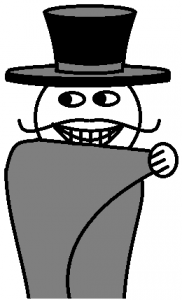Villains, or antagonists, have come a long way. During the history of literature, they may have evolved even more than heroes, or protagonists. We’ll discuss that evolution, and show you how to create a well-written villain for your story.
A villain is a character opposed to the protagonist, who is usually cruel and who may be involved with crime. Not all stories have villains. The word ‘villain’ comes from the same root as ‘villa’ and once simply meant ‘farmhand.’ Only later did the word get loaded down with evil connotation baggage.
 For centuries, when much of literature served the purpose of inculcating morality, authors portrayed villains as one-dimensional characters devoted to pure evil. Writers made it easy for the reader to distinguish the villainous characters from the good ones, by appearance, speech, and actions. Authors provided no reason for the villain’s malevolent nature, nor were such reasons expected. The villain was just bad, that’s all.
For centuries, when much of literature served the purpose of inculcating morality, authors portrayed villains as one-dimensional characters devoted to pure evil. Writers made it easy for the reader to distinguish the villainous characters from the good ones, by appearance, speech, and actions. Authors provided no reason for the villain’s malevolent nature, nor were such reasons expected. The villain was just bad, that’s all.
Then a change occurred in literature, and villains evolved. From the timing, I associate it with the advent of psychology, the study of the human mind and behavior. I may be wrong about that linkage, but it makes sense to me.
Since the early- to mid-Twentieth Century, it has not been enough to portray a villain as purely evil, without explanation. Gone are the black cape, the curled moustache, and the menacing sneer. (Well, maybe you can use such a stereotypical character for comedic effect.)
The modern villain starts out as a normal person, indistinguishable from any other character. Something happens to that person; a disturbing event triggers a change in the way they think. (Rather than a single event, the character could be raised from childhood in a peculiar way, but then that way must have an explanation.) The character twists the event, obsesses about it, and it becomes a driving factor for later behavior.
As this happens, the villain may not change in outward appearance, so he or she will be indistinguishable from other characters. This warping toward villainy occurs only in the antagonist’s mind. The resulting villain will likely have many good, even endearing, traits, all while harboring a secret inner drive toward nefarious ends.
While writing your story, you’ll need to convey this explanation for your villain’s behavior, even if it’s backstory. No modern reader will accept a character who is evil ‘just because.’
Moreover, the chain of events must lead to the villain being opposed to the hero. The protagonist and antagonist are a matched set. Often, the villain’s desired ends have nothing to do with the hero, but the hero becomes the irritant the villain must deal with to achieve his goal.
To ensure your story is interesting and to give your protagonist a worthy problem to solve, the villain must be at least as smart and powerful as the hero. Your hero must strive beyond his or her own perceived limits, and suffer nearly insurmountable hardships to overcome the villain. But neither can your villain be invulnerable. You should depict your villain as being on a quest of his own, contending with problems where not all of his machinations work all the time.
In preparing this post I studied, and villainously stole from, other wonderful posts on this topic, including this one on wikiHow, the Wikipedia article on ‘Villain,’ and Hallie Ephron’s article in Writer’s Digest. I encourage you to read each one for more in-depth information.
Now you should be ready to create your own villain. With this blog post finished, I can get back to my fiendish scheme to take over the internet! Bwa-ha-ha-ha! Soon the entire world will bow down to—
Poseidon’s Scribe
